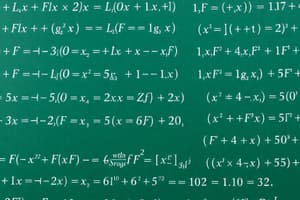Podcast
Questions and Answers
Which of the following is an example of a quadratic equation?
Which of the following is an example of a quadratic equation?
- 3x + 2 = 5
- 2x + 1 = 0
- x² - 4x + 4 = 0 (correct)
- 5x = 3x + 7
What is the sine of angle θ in terms of the sides of a right triangle?
What is the sine of angle θ in terms of the sides of a right triangle?
- Hypotenuse/Opposite
- Adjacent/Opposite
- Opposite/Hypotenuse (correct)
- Adjacent/Hypotenuse
When simplifying the expression 2x + 3x, what is the resulting expression?
When simplifying the expression 2x + 3x, what is the resulting expression?
- 5x (correct)
- x + 3
- 2 + 3x
- 3 + 2x
Which trigonometric ratio is equivalent to the cosine of an angle?
Which trigonometric ratio is equivalent to the cosine of an angle?
What operation would you perform to isolate the variable x in the equation 3x - 5 = 10?
What operation would you perform to isolate the variable x in the equation 3x - 5 = 10?
Which of the following statements correctly represents the Law of Cosines?
Which of the following statements correctly represents the Law of Cosines?
What is the reciprocal function of sine?
What is the reciprocal function of sine?
What is the equation of a linear function?
What is the equation of a linear function?
Flashcards are hidden until you start studying
Study Notes
Algebra
- Definition: A branch of mathematics dealing with symbols and the rules for manipulating those symbols.
- Key Concepts:
- Variables: Symbols (often x, y, z) used to represent numbers.
- Expressions: Combinations of variables, numbers, and operations (e.g., 2x + 3).
- Equations: Statements that two expressions are equal (e.g., 2x + 3 = 7).
- Functions: Relationships between inputs and outputs, often written as f(x).
- Operations:
- Addition and Subtraction: Combine like terms to simplify expressions.
- Multiplication and Division: Apply distributions and factorization.
- Solving Equations: Techniques include isolating variables, substitution, and using inverse operations.
- Types of Equations:
- Linear Equations: Form y = mx + b; graphs as straight lines.
- Quadratic Equations: Form ax² + bx + c = 0; can be solved using factoring, completing the square, or quadratic formula.
- Polynomial Equations: Involves terms with exponents; can include various degrees.
Trigonometry
- Definition: A branch of mathematics dealing with relationships between the angles and sides of triangles.
- Key Concepts:
- Trigonometric Ratios: Ratios of sides in a right triangle.
- Sine (sin) = Opposite/Hypotenuse
- Cosine (cos) = Adjacent/Hypotenuse
- Tangent (tan) = Opposite/Adjacent
- Trigonometric Ratios: Ratios of sides in a right triangle.
- Key Functions:
- Reciprocal Functions:
- Cosecant (csc) = 1/sin
- Secant (sec) = 1/cos
- Cotangent (cot) = 1/tan
- Reciprocal Functions:
- Unit Circle:
- Defines trigonometric functions for all angles; crucial for understanding function behavior.
- Coordinates of points (cos(θ), sin(θ)) correspond to angles θ in standard position.
- Laws:
- Pythagorean Theorem: a² + b² = c², relates sides of right triangles.
- Law of Sines: (a/sin A) = (b/sin B) = (c/sin C); relates ratios of sides to angles.
- Law of Cosines: c² = a² + b² - 2ab(cos C); generalizes Pythagorean theorem for non-right triangles.
- Applications: Used in physics, engineering, computer science, and architecture. Commonly applied in wave functions, oscillations, and circular motion.
Algebra
- Definition: Branch of mathematics focusing on symbols and the rules for manipulating them.
- Key Concepts:
- Variables: Symbols (often x, y, z) representing unknown numbers.
- Expressions: Combinations of variables, numbers, and operations (e.g., 2x + 3).
- Equations: Statements declaring two expressions as equal (e.g., 2x + 3 = 7).
- Functions: Relationships between inputs and outputs, often written as f(x).
- Operations:
- Addition and Subtraction: Simplify expressions by combining like terms.
- Multiplication and Division: Apply distributions and factorization.
- Solving Equations: Techniques include isolating variables, substitution, and using inverse operations.
- Types of Equations:
- Linear Equations: Form y = mx + b, with graphs as straight lines.
- Quadratic Equations: Form ax² + bx + c = 0, solved through factoring, completing the square, or the quadratic formula.
- Polynomial Equations: Include terms with exponents, categorized by their degrees.
Trigonometry
- Definition: Branch of mathematics dedicated to exploring relationships between angles and sides of triangles.
- Key Concepts:
- Trigonometric Ratios: Ratios of sides in a right triangle.
- Sine (sin) = Opposite/Hypotenuse.
- Cosine (cos) = Adjacent/Hypotenuse.
- Tangent (tan) = Opposite/Adjacent.
- Trigonometric Ratios: Ratios of sides in a right triangle.
- Key Functions:
- Reciprocal Functions:
- Cosecant (csc) = 1/sin.
- Secant (sec) = 1/cos.
- Cotangent (cot) = 1/tan.
- Reciprocal Functions:
- Unit Circle:
- Defines trigonometric functions for all angles, providing a visual understanding of their behavior.
- Coordinates of points (cos(θ), sin(θ)) represent angles θ in standard position.
- Laws:
- Pythagorean Theorem: a² + b² = c², relating the sides of a right triangle.
- Law of Sines: (a/sin A) = (b/sin B) = (c/sin C), connecting ratios of sides to angles.
- Law of Cosines: c² = a² + b² - 2ab(cos C), generalizing the Pythagorean theorem for non-right triangles.
- Applications: Used extensively in Physics, Engineering, Computer Science, and Architecture, particularly in understanding wave functions, oscillations, and circular motion.
Studying That Suits You
Use AI to generate personalized quizzes and flashcards to suit your learning preferences.




